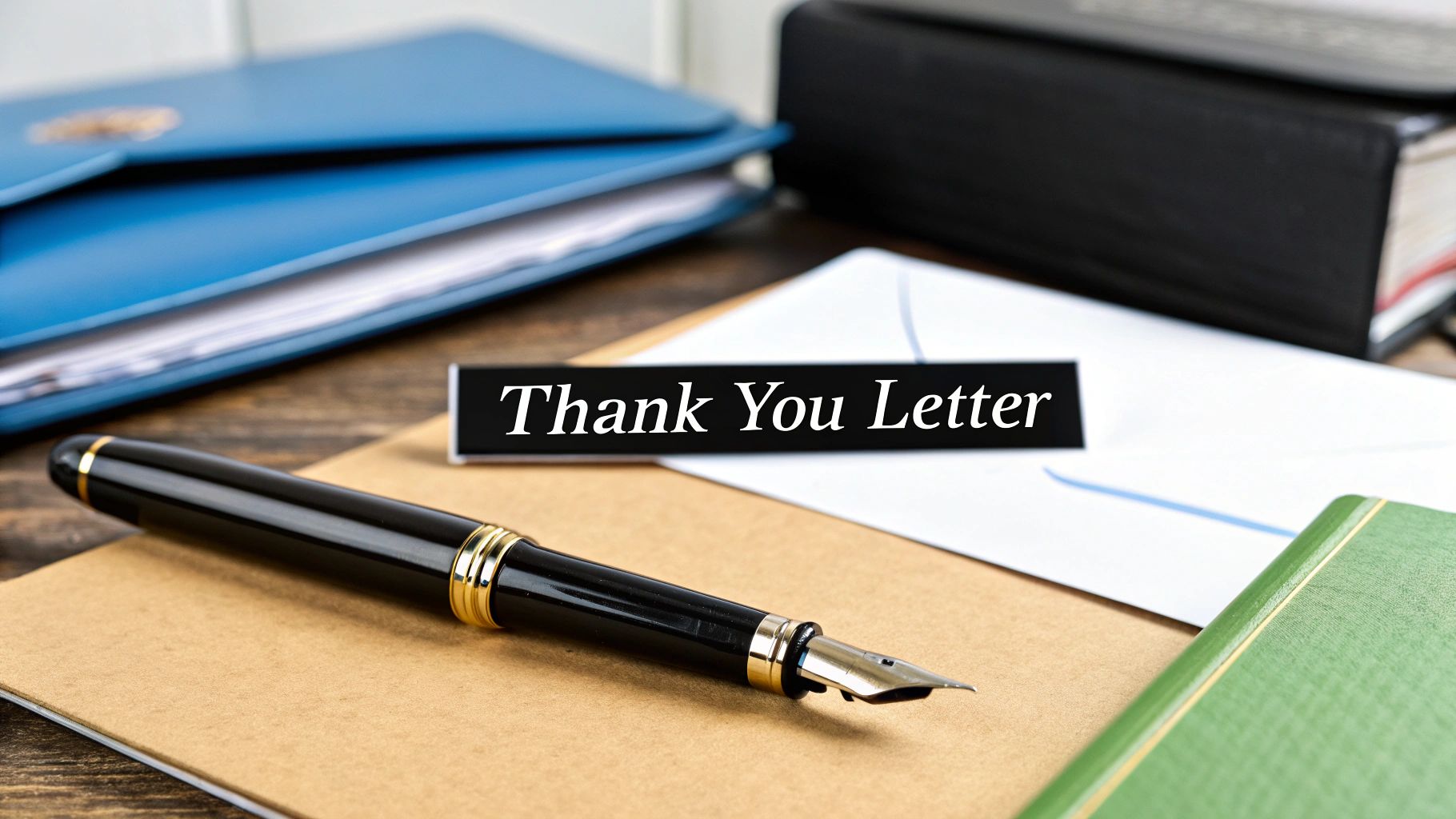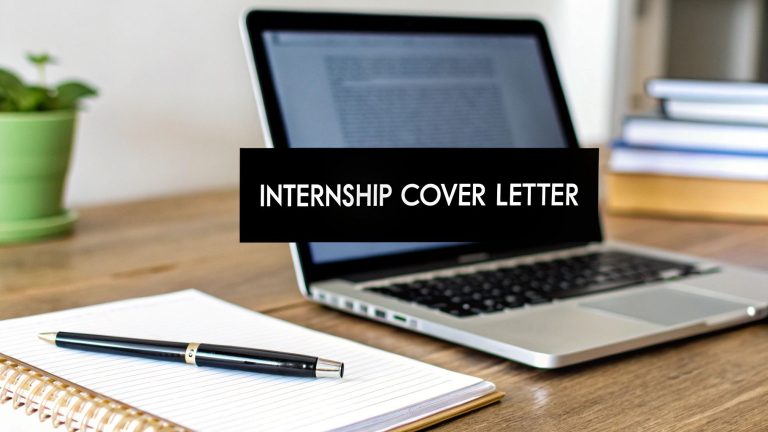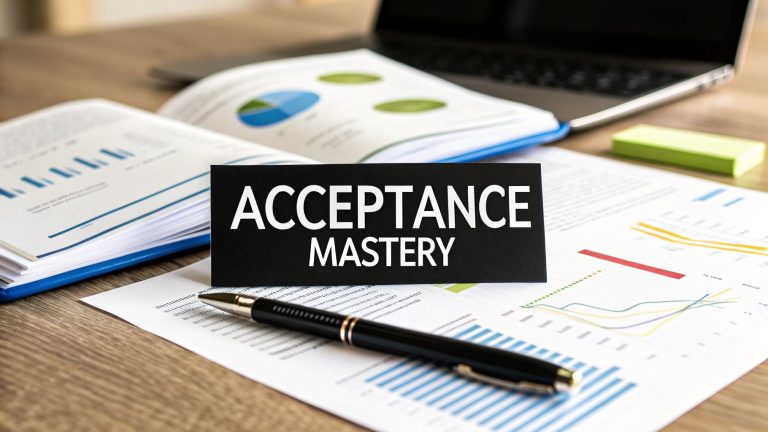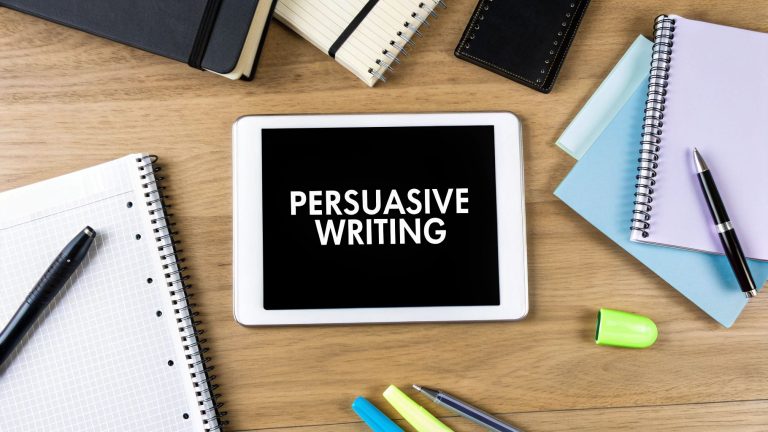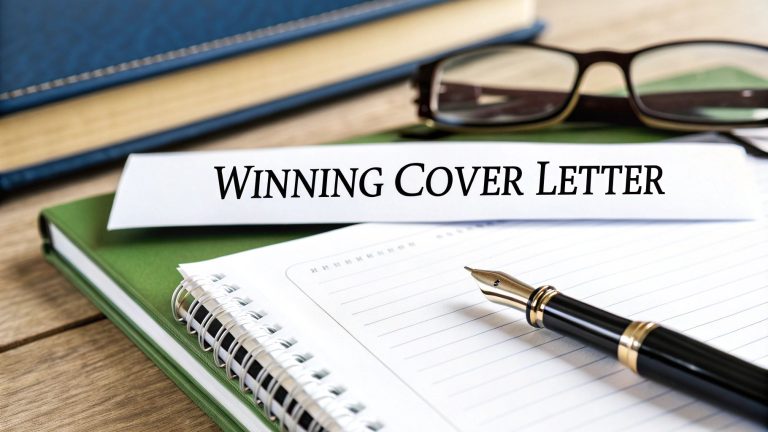In a world of overflowing inboxes and fleeting digital messages, the business thank you letter has become a secret weapon for building real, lasting professional relationships. It’s more than just good manners. A well-crafted, personal note shows you genuinely care, which goes a long way toward building client loyalty and keeping your team's spirits high.
Why Bother With a Thank You Letter Anymore?
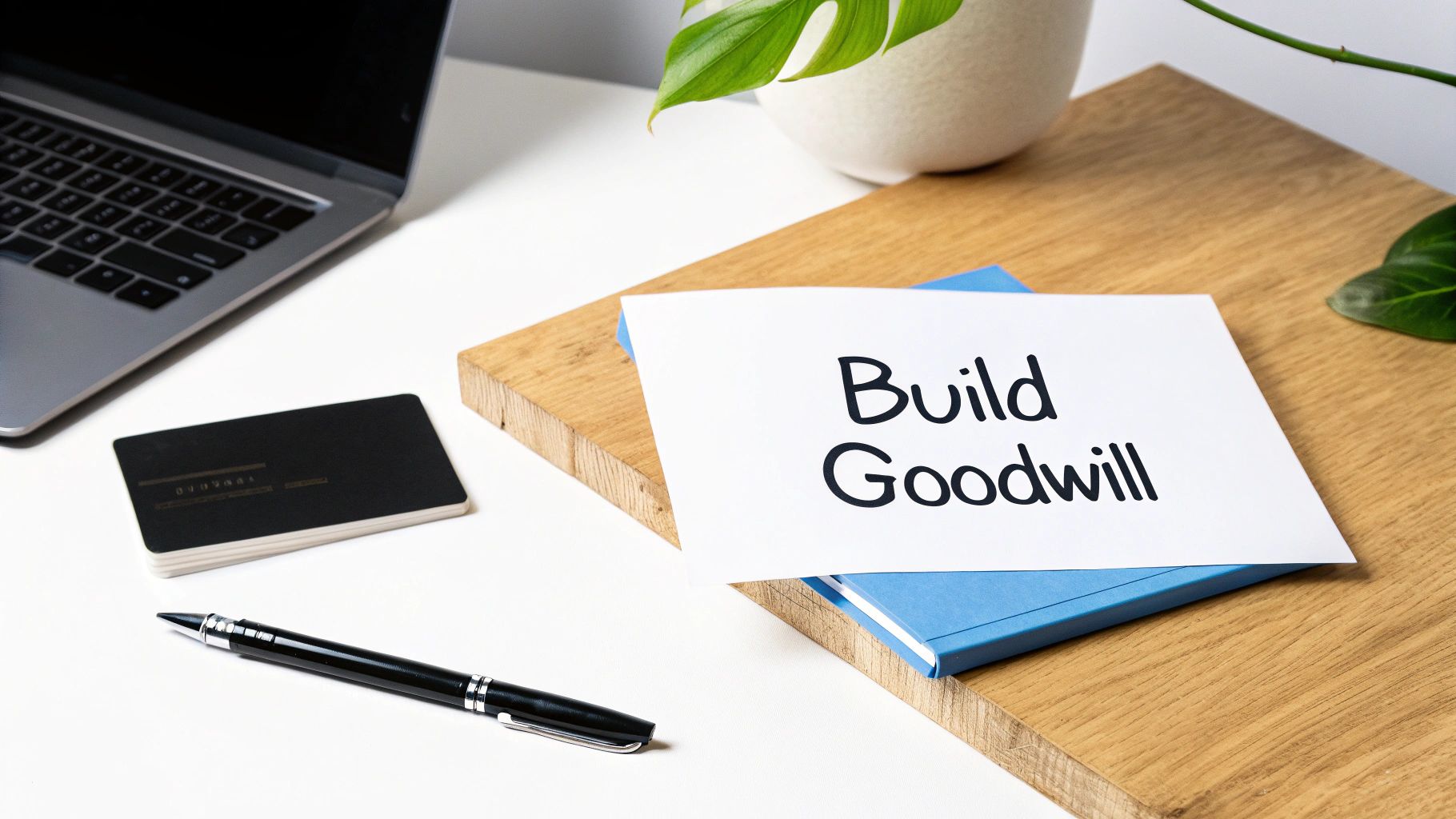
Think about it. When everything is automated and instant, taking a moment to actually write and send a physical letter really stands out. It cuts through all that digital noise. It's a deliberate, thoughtful act that shows the other person you value them enough to invest your time, leaving a much stronger impression than an emoji-filled Slack message ever could.
This isn't just a hunch I have from years in business; there's real science behind it. Studies have shown that handwritten letters pack a surprisingly powerful emotional punch. In one piece of research, almost every single person who received one felt genuinely touched. That's because a sincere business thank you letter forges a real human connection.
Appreciation Is a Smart Business Move
Sending a thank you note at the right time is more than just a kind gesture—it’s a strategic one. It’s your chance to follow up, remind someone of your value, or simply strengthen a bond for the future.
For example, after wrapping up a big project, a letter doesn't just thank the client for their payment. It reinforces the positive experience, reminds them of the great work you did together, and keeps the door wide open for repeat business and referrals.
This simple act shows that you see them as a partner, not just a transaction. That's how you build the kind of goodwill and trust that leads to long-term success.
A simple thank you can transform a one-time client into a lifelong advocate or turn a good employee into a great one. It’s an investment in human connection with an incredible ROI.
Making this a regular habit is all about knowing when and how to do it effectively. For more on this and other powerful communication tips, take a look at our guide to business communication best practices. At the end of the day, it's about making appreciation a core part of how you do business.
The 3 Key Ingredients of a Thank You Letter That Actually Works
A great business thank you letter isn't about flowery language or reciting tired, generic phrases. It's about making a genuine connection. When I write one, I always focus on three core components that work together to make the message feel personal and sincere, not like it came from a template.
Getting these right is what turns a simple note into a powerful relationship-building tool.
First, I always start with a specific and immediate opening. Forget vague lead-ins like "Just wanted to say thanks." That’s a missed opportunity. Instead, get straight to the point and mention exactly why you're writing.
For example, "Thank you for taking the time to walk me through the Q3 proposal yesterday" instantly connects your letter to a real, shared moment. It makes your message relevant from the very first line.
Giving Your Message Some Real Substance
The body of the letter is where the magic happens. This is your chance to explain why their action mattered and show the real impact it had. This is what makes your gratitude feel earned and significant.
Here’s a simple formula I follow to make the message count:
- Pinpoint the specific action. Instead of "Thanks for the advice," I'd write, "Your advice on how to reframe our value proposition was incredibly helpful."
- Show the positive result. Then, I connect it to an outcome. "Because of your insight, we were able to secure that follow-up meeting with the new stakeholder."
- Look to the future. I always end the body by showing I value the relationship. "I'm looking forward to collaborating on the next phase of this project."
This level of detail proves you were paying attention and truly valued what they did. Of course, the content is only half the battle; proper formatting makes it look professional. For a deep dive into that, our guide on how to format a letter covers all the bases.
How to End on a High Note
Finally, you need a strong closing to leave a lasting positive impression. This is your final chance to reinforce the connection. It should feel warm, authentic, and forward-looking.
While a classic "Sincerely" or "Best regards" works just fine, adding a personal touch can elevate it.
A great closing line might be something like, "I'm excited to see what we can accomplish together next," or "Again, thank you for your exceptional support." It's a final, sincere nod that ends things perfectly.
The most important thing is that your voice feels like you. Write in a style that matches your actual relationship, whether that’s formal or a bit more casual. Authenticity is what makes any thank you letter truly land.
Key Moments for Sending a Thank You Letter
In business, timing is everything. And when it comes to sending a thank you letter, the right moment can transform a simple courtesy into a powerful tool for building lasting relationships. Most people default to sending one after a job interview, but some of the most impactful opportunities are hiding in plain sight, right in your day-to-day operations.
Knowing when to send a note of thanks allows you to show appreciation when it’s least expected but most effective. A well-timed, thoughtful letter can smooth over a bumpy project, reinforce a great experience, and solidify your reputation as a considerate professional.
This infographic lays out a simple but effective roadmap for writing a note that truly lands, covering everything from the opening line to the final sign-off.
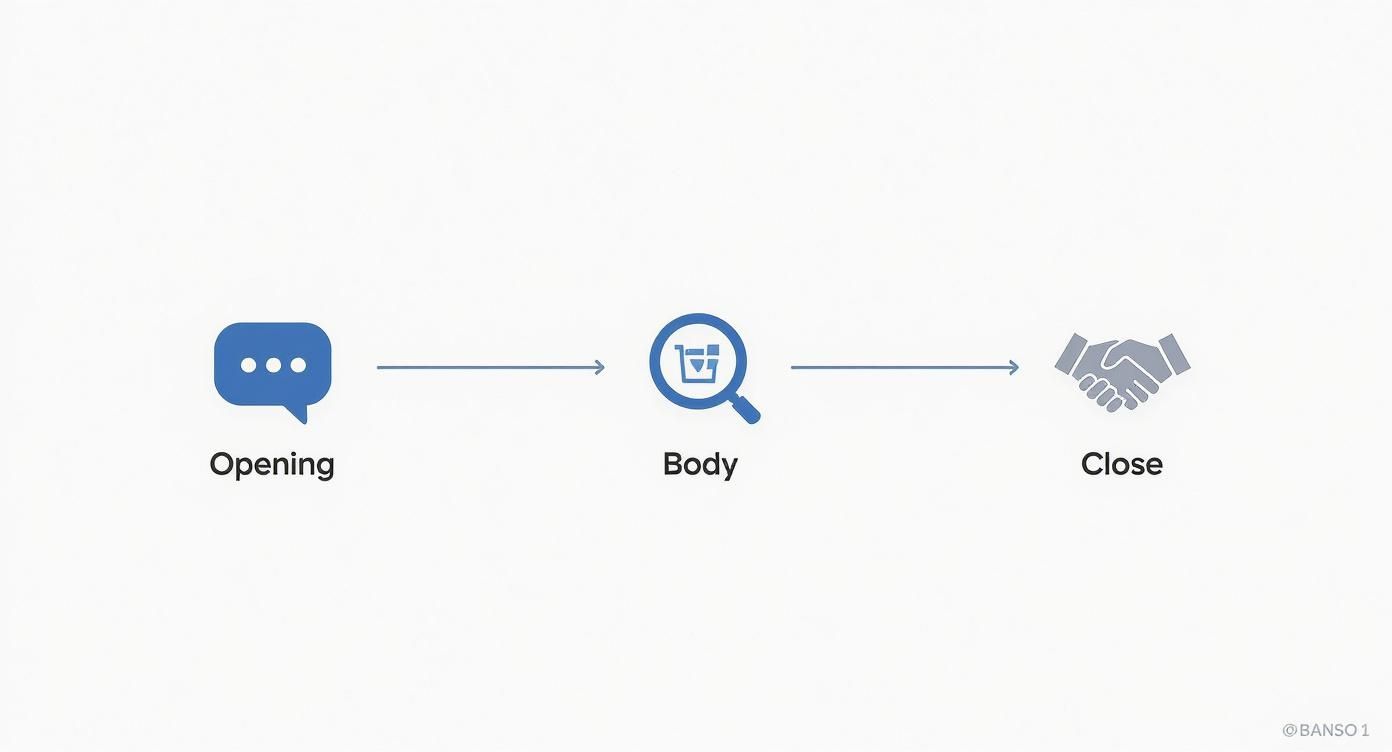
As you can see, a powerful letter has three core parts: a specific opening, a detailed body, and a forward-looking close. Get these three things right, and your message will resonate.
After a Project Wraps or a Big Purchase Is Made
The moment a client signs a big contract or finalizes a major purchase is critical. They're often second-guessing their decision, and this is your window to step in. A thank you letter at this stage does more than just show gratitude; it validates their choice and starts the new relationship on a high note.
- For a brand-new client: Your letter can ease any potential buyer's remorse and signals your commitment right from the start.
- For a loyal, long-term client: It’s a chance to acknowledge their continued trust and make them feel genuinely valued, not just like another invoice number.
This one small action can do wonders for client retention and often leads to those priceless word-of-mouth referrals.
Following a Job Interview
This one’s a classic for a good reason. Sending a thank you note after an interview keeps you fresh in the hiring manager’s mind and is a clear signal of your professionalism and follow-through. An email is quick and standard, but don't underestimate the power of a handwritten note to help you stand out, especially if you're going for a senior-level position.
A prompt, personalized follow-up reinforces your enthusiasm for the role and gives you one last chance to touch on a key qualification or a connection you made during the conversation.
It’s a small detail that can make a huge difference when you’re up against other qualified candidates. If you need some ideas for what to say, this collection of email after interview samples offers some great starting points.
When Someone Gives Exceptional Support
Never forget the people who help you get the job done. Did a vendor pull out all the stops to meet a crazy deadline? Did a colleague jump in to help you with a tough project? These are perfect moments for a thank you letter.
Putting your appreciation in writing makes people feel seen and valued. It’s an investment in goodwill that strengthens your professional network and encourages a more collaborative environment. This goes for mentors, partners, and team members, too—anyone who provides that invaluable support when you need it most.
Putting Business Thank You Letters into Practice
Knowing the theory is one thing, but seeing how a business thank you letter works in the real world is where the magic happens. The goal is always to get specific. Forget the generic templates; your message needs to feel personal and tailored to the exact situation.
Let's walk through a couple of common scenarios to see how this plays out. You'll notice each example has a clear and direct opening, a body that explains why you're thankful, and a closing that looks to the future.
Thanking a Long-Term Client
You've just wrapped up a major, year-long project with a cornerstone client. A thank you note here does more than just show appreciation for their business—it solidifies the relationship and acknowledges the trust they placed in you.
Here's an example:
Dear Sarah,
I wanted to personally thank you for the incredible partnership on the "Project Phoenix" initiative this past year. Your team's clear vision and quick feedback were absolutely essential in helping us navigate the complexities and, ultimately, deliver the final platform ahead of schedule.
I was particularly grateful for your insights during our Q3 planning session. Your idea to rethink the user testing strategy truly saved us weeks of work and made the end result that much stronger. It’s that kind of collaboration that makes our work feel so meaningful.
We're incredibly proud of what we've built together and are excited to support you as you move into the next phase. Let's catch up next week to chat about the rollout.
Best regards,
Alex
See how specific that is? Mentioning "Project Phoenix" and the "Q3 planning session" shows you were paying attention. It proves your gratitude is genuine, not just a formality.
Appreciating a Valued Partner or Vendor
Your network of partners and vendors is a crucial part of your success. When one of them goes the extra mile, taking a moment to acknowledge it can build an incredible amount of goodwill.
A well-timed thank you can turn a good vendor relationship into a great one. It shows you see them as a true partner in your success, not just a line item on an invoice.
Let's say a supplier rushed a critical shipment to help you meet a tight deadline.
Take a look at this:
Hi David,
I'm writing to say a huge thank you for your team's amazing work on expediting our last component order. I know it was a big ask at the last minute, but your fast turnaround allowed us to meet our client's deadline without a single issue.
Your flexibility made all the difference and honestly saved the day for us. We really value the reliability and support you and your team consistently provide.
Thanks again for being such a fantastic partner.
All the best,
Maria
If you need more ideas, you can find a wide variety of thank you note examples for different professional situations. Seeing how others frame their appreciation can help you find the right words to strengthen your own business relationships.
Recognizing Your Team with Thank You Letters
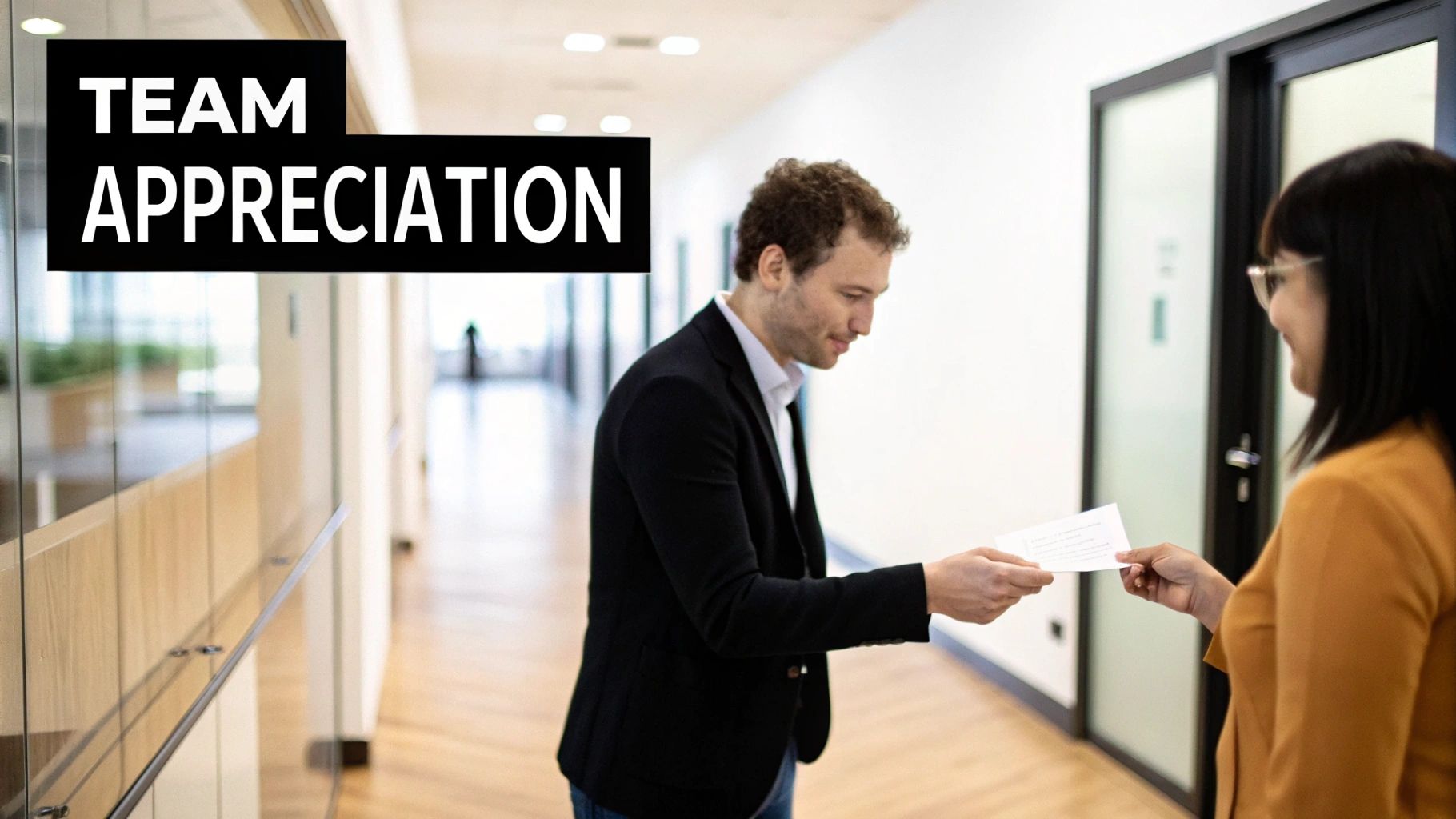
While we often focus on thanking clients, turning that same energy inward can completely transform your company culture. The humble business thank you letter isn't just for external partners; it's one of the most powerful—and underused—tools for recognizing your own people.
It’s easy to think a small cash bonus is the best way to say thanks, but sincere, written appreciation often hits harder. Why? Because it’s personal and intentional. This simple act directly fuels employee engagement and loyalty. In fact, studies have found that 65% of employees actually prefer non-monetary rewards, like a thoughtful note, over other incentives.
Making Internal Recognition Count
As a manager, a thank you note is your chance to show an employee exactly how their work connects to the bigger picture. Don't just dash off a "Great job on the report." Get specific about why it mattered.
- Pinpoint the contribution: What specific action did they take that stood out?
- Show the impact: How did their effort help the team, the project, or the company?
- Affirm their value: End with a line that reinforces how much you appreciate their unique skills.
A letter that says, "Sarah, your detailed analysis in the Q3 report helped us spot a major risk, saving us from a huge potential setback," is infinitely more meaningful than a generic compliment. It proves you're actually paying attention.
Peer-to-peer recognition is just as crucial. When you encourage team members to thank one another, you build a genuinely collaborative and supportive atmosphere. It can be as simple as leaving a sticky note on a colleague's monitor after they stayed late to help you meet a deadline.
These small, consistent gestures create a foundation of mutual respect and high morale. If you need some inspiration for acknowledging a colleague's great work, you can even adapt the framing from our guide on writing a recommendation letter for a coworker.
A Few Common Questions About Business Thank You Letters
Even seasoned professionals can get tripped up by the finer points of business etiquette. When you're sitting down to write a business thank you letter, a few questions almost always come to mind. Let's clear those up so your message always hits the right note.
Is an Email Thank You Okay for Business?
Yes, absolutely. In many situations, an email isn't just acceptable; it's the expected way to follow up. Think about after a job interview—speed matters. An email shows you're on top of things and engaged. It’s professional, efficient, and gets the job done.
That said, a handwritten note has a different kind of power. When you want to strengthen a really important relationship, celebrate a big milestone, or just leave a lasting impression, taking the time to send a physical card speaks volumes. It’s a personal touch that an email just can't match.
How Long Should My Thank You Letter Be?
Keep it short and sweet. You’re aiming for sincere impact, not a novel. A few well-written paragraphs are all you need to get your message across clearly and effectively.
A good way to structure it is with three simple parts:
- Start by directly stating why you're grateful.
- Then, add a specific detail about what you appreciated.
- Finally, wrap it up with a warm, simple closing.
What are the Big Mistakes to Avoid?
The most common traps are being too generic, having typos, and waiting too long to send it. A vague "Thanks for everything" feels impersonal and doesn't really mean much.
Always try to mention something specific. Did they offer a great piece of advice? Did their contribution to a project make a real difference? Calling out a specific detail makes your gratitude feel authentic and considered.
Also, always give it a final proofread. A simple spelling mistake can undermine an otherwise perfect note. And try to get your letter out within 24-48 hours. Timeliness shows that your appreciation is genuine and a priority.
Still staring at a blank page? The AI Letter Generator can give you a great starting point. Just plug in a few details, and it will create a polished, professional draft in seconds. Try AI Letter Generator for free and see how easy it is.
